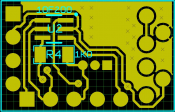toodle_pipsky
Minister of Silly Walks
Just looking @ these stobe PCBs and working out how it goes together! Most parts are obvious where they goe, just 3 questions:
1. Where does the LED go?
2. On the left side (looking at the board with U1 up the correct way) is that were header pins go to connect my PICkit 2 to program the pic? part 2 of that question is will I need to do that to each strobe (that is put header pins in and program each one)?
3. How do you wire up the connection to these - connection to strobe and connection to computer? Can you connect them in series or parrallel to run many from 1 channel?
Thanks for the help - they probably seem like obvious questions, but the wiki page doesn't have much info yet.
1. Where does the LED go?
2. On the left side (looking at the board with U1 up the correct way) is that were header pins go to connect my PICkit 2 to program the pic? part 2 of that question is will I need to do that to each strobe (that is put header pins in and program each one)?
3. How do you wire up the connection to these - connection to strobe and connection to computer? Can you connect them in series or parrallel to run many from 1 channel?
Thanks for the help - they probably seem like obvious questions, but the wiki page doesn't have much info yet.





